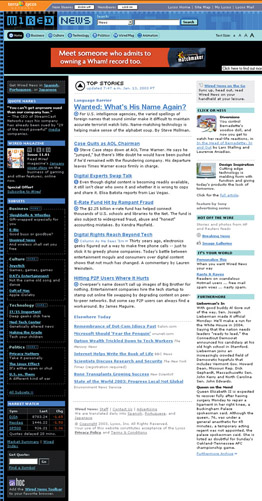index_A
Wired News: Why Standards and CSS?
While I've made a strong case for standards-based design in this book, it certainly helps to take a look at how true change occurs. Wired News has consistently been ahead of the design game in both its print and web manifestations. Known for wild color schemes and interesting content for today's tech-culture savvy individual, Wired News has always stood out from the more conventional publishers by creating a persona that is edgy and contemporary (see Figure 9.1).

Figure 9.1: Wired News: Home Page
For that quality alone it stands to reason that Wired News would take the lead in the progressive choice of designing the Web the way web leaders believe the Web should be designed.
In Bowman's documentation of the process of redesigning Wired News to standards, he makes another important point: That other designers and developers should be 'encouraged to follow as we help push the Web to a higher ground.'
But make no mistake-Bowman's challenge was particularly difficult, despite the many advantages and impressive design that emerged as a result. Wired News isn't a home page, nor is it even a medium-sized business site. It is a large-scale, content-heavy, database-driven, highly trafficked, and ad-supported site. This means that it's the most complicated type of site to get up to speed with standards, because there are so many details to address.
What's more, anyone else working on the site, whether designer, markup and CSS person, programmer, or database designer, needs to have some modicum of standards education to make sure the end results are valid.
Bowman points out that despite these challenges, there are significant advantages to using XHTML and CSS. Some of the advantages Bowman describes include:
-
Adherence to W3C recommendations 'represents a broader participation in pushing the Web to a higher ground.'
-
The power of XML makes markup 'cleaner, leaner, and more logical.'
-
Use of CSS for layout removes 'complex nested tables.'
-
More support for more browsers.
-
Portability and interoperability, because cleaner documents can easily be used for other platforms, such as wireless.
-
Accessibility.
-
Longer lasting documents and document structure-no need to create 'hacks' for each new browser version.
-
Error reduction due to valid documents.
-
Speed of cleaner files is increased, file sizes are often decreased (see Chapter 7, 'Reconstructing a Table-Based Site').
-
Future redesigns can be managed efficiently.
While each of these points are conceivably entire topics of study, combined they make a powerful case for Wired News' redesign, and the use of XHTML and CSS in general.
EAN: 2147483647
Pages: 86
- The Four Keys to Lean Six Sigma
- When Companies Start Using Lean Six Sigma
- Making Improvements That Last: An Illustrated Guide to DMAIC and the Lean Six Sigma Toolkit
- The Experience of Making Improvements: What Its Like to Work on Lean Six Sigma Projects
- Six Things Managers Must Do: How to Support Lean Six Sigma